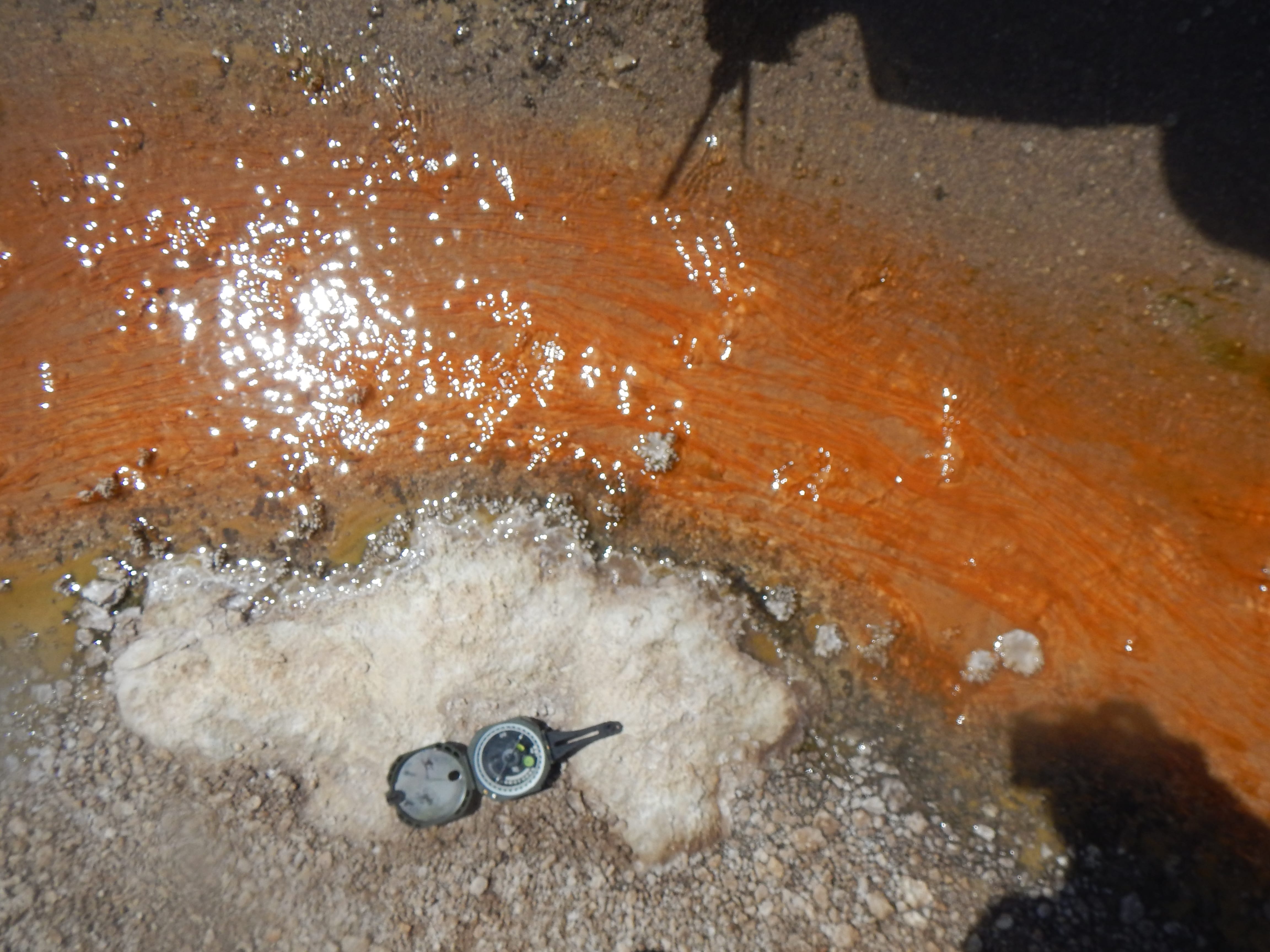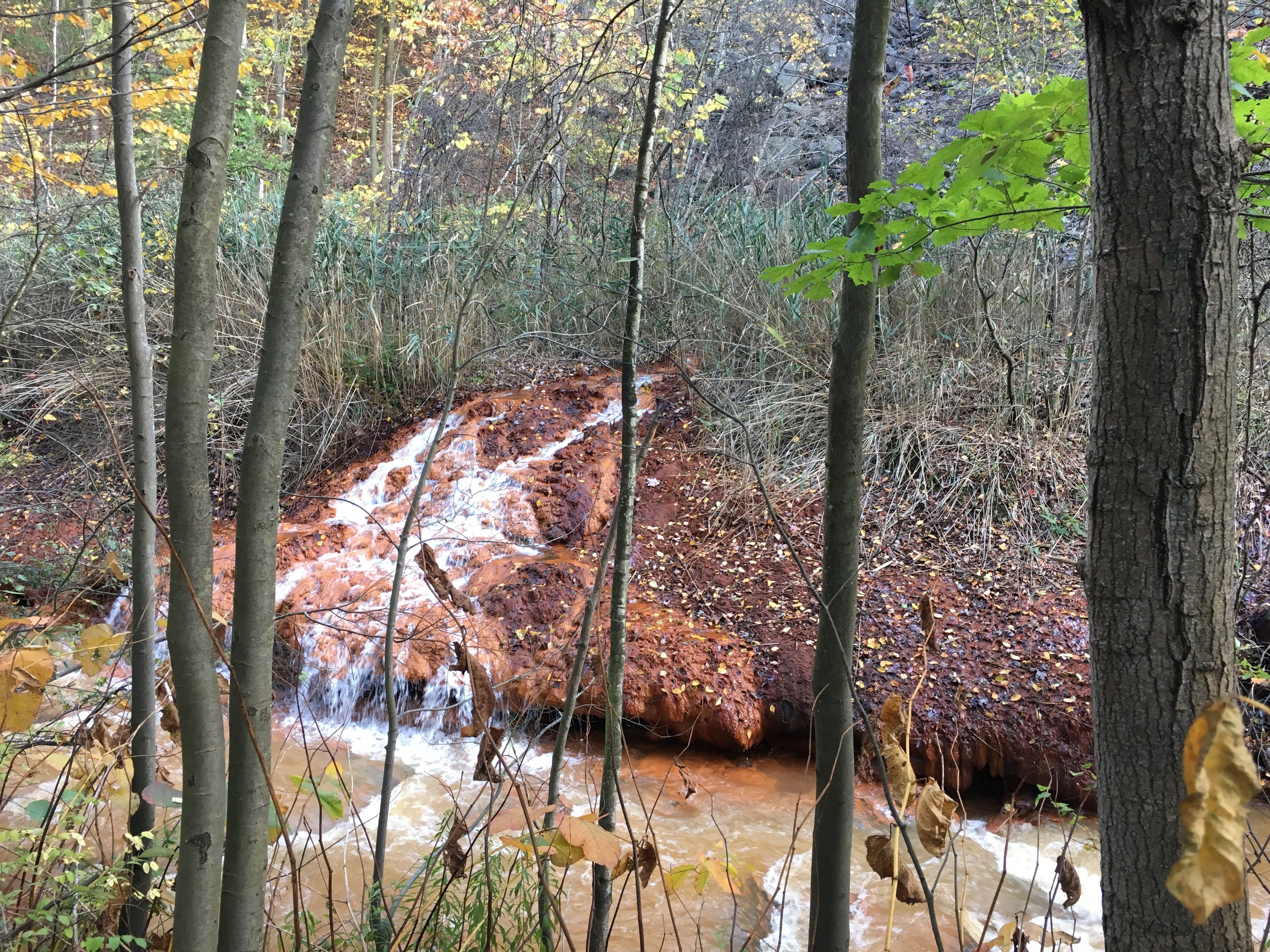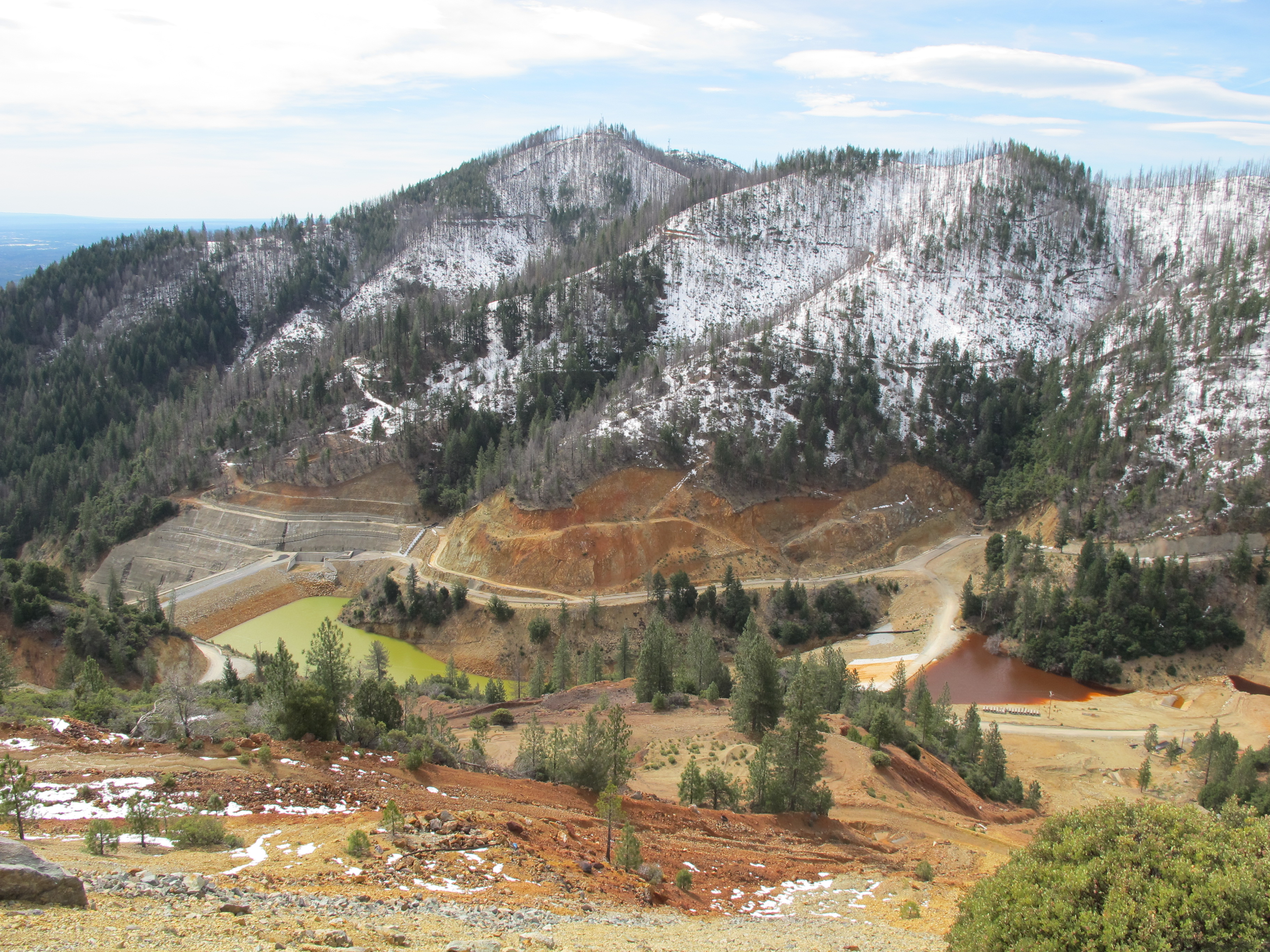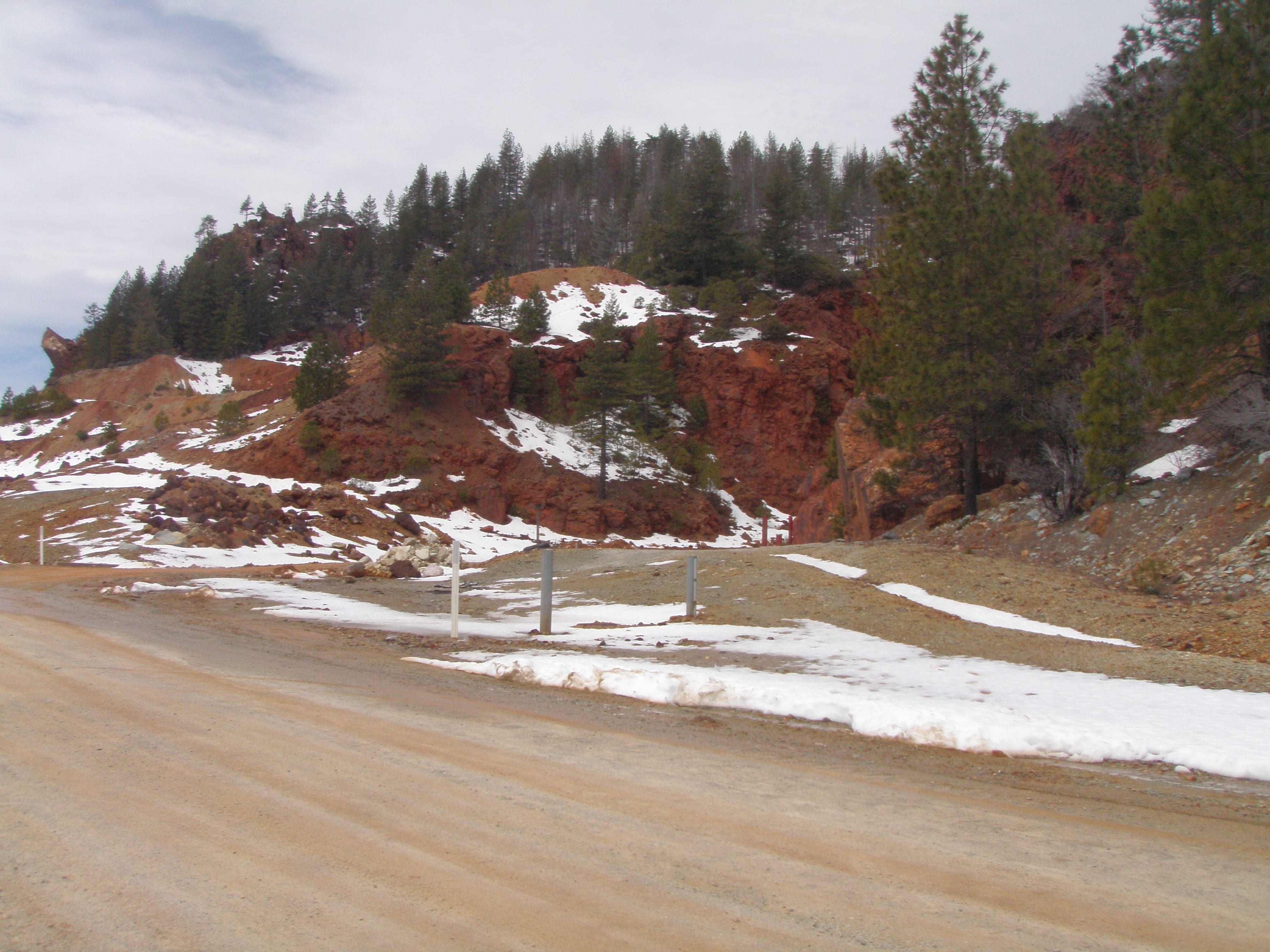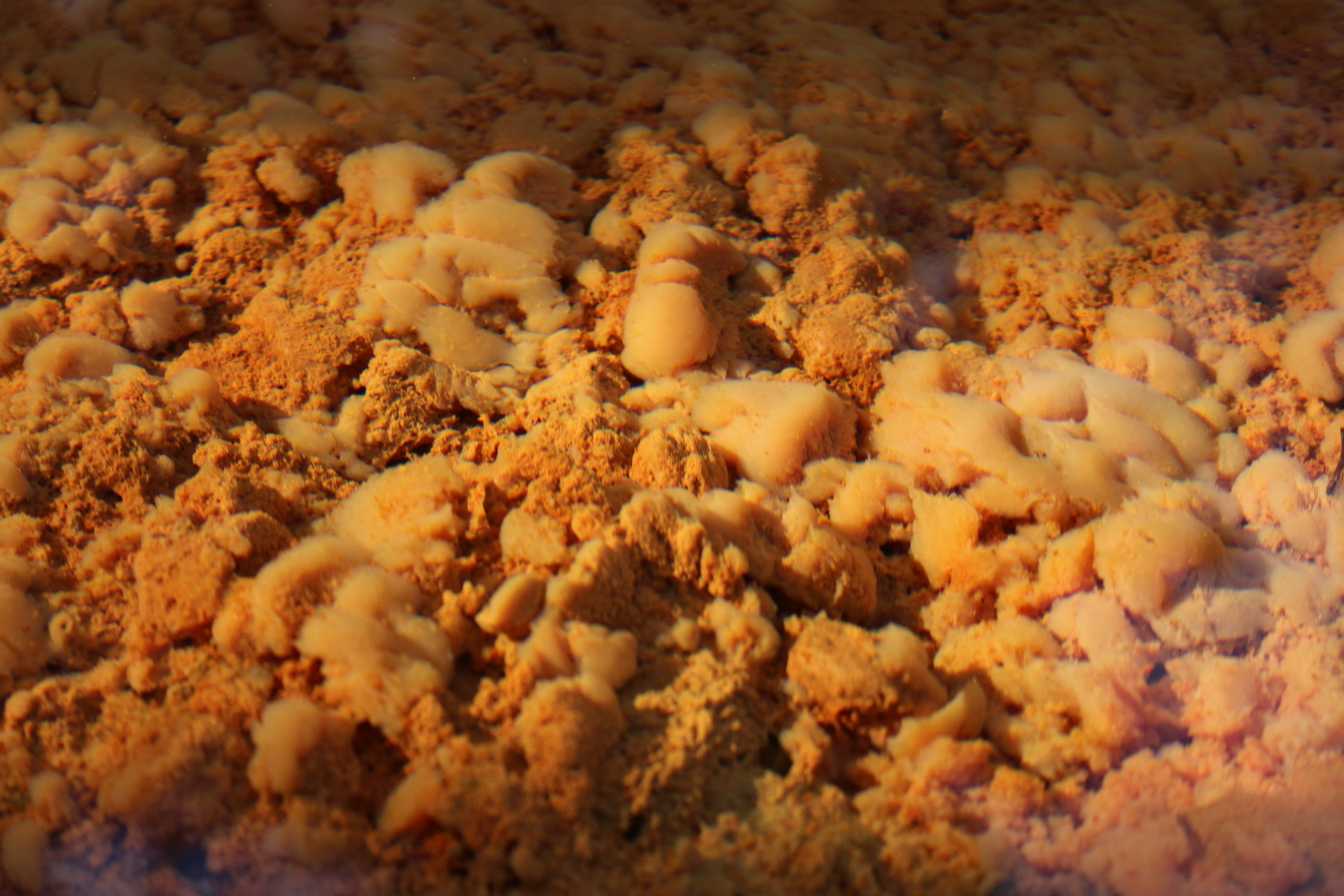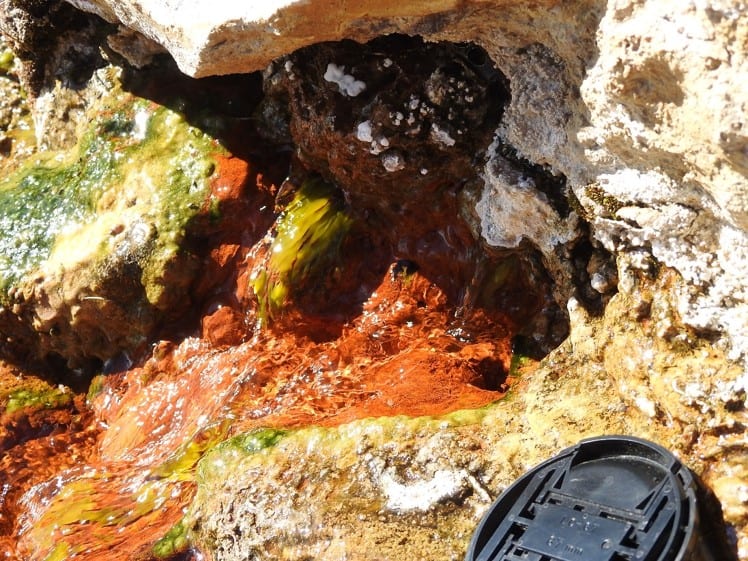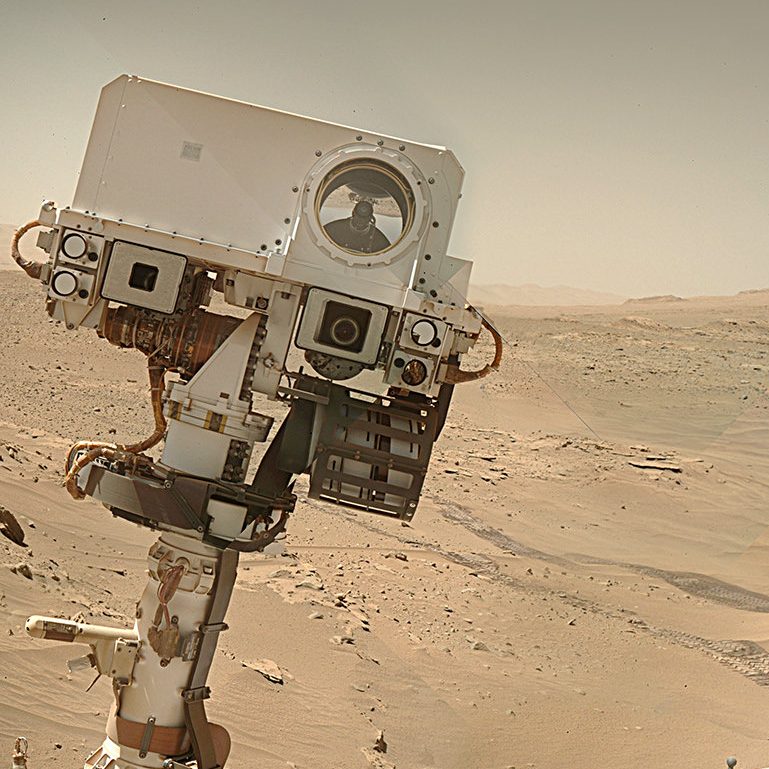Current Research Projects
Organic Preservation in Hot Springs from the El Tatio Geyser
 The Atacama Desert presents an arid and cold Mars analog environment for the study of organics preservation. Hot springs in the El Tatio geyser field host a diversity of stromatolitic features, including digitate stromatolites. These stromatolites are considered an analog to similar siliceous features in the discovered by the Mars Exploration Rover Spirit in Columbia Hills, Gusev crater, Mars. We are exploring the preservation of organic molecules within these stromatolites to determine if future Mars mission payloads could detect organic molecules in similar amorphous silica deposits.
The Atacama Desert presents an arid and cold Mars analog environment for the study of organics preservation. Hot springs in the El Tatio geyser field host a diversity of stromatolitic features, including digitate stromatolites. These stromatolites are considered an analog to similar siliceous features in the discovered by the Mars Exploration Rover Spirit in Columbia Hills, Gusev crater, Mars. We are exploring the preservation of organic molecules within these stromatolites to determine if future Mars mission payloads could detect organic molecules in similar amorphous silica deposits.
The Geobiology and Geochemistry of Acid Mine Drainage Systems
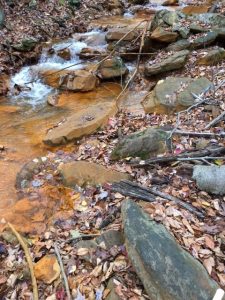
Acid mine drainage (AMD) systems are some of the most extreme environments for life on Earth and serve as a robust analog for Martian environments. Centralia, Pennsylvania, hosts such an environment: an abandoned coal mine with an active subterranean coal fire and surficial acid mine drainage system. My research explores the source of the geochemically anomalous AMD and the potential role of extremophilic organisms in this system. Centralia, PA, was a robust coal mining town from the 1840’s to the 1960’s. The Centralia Mine Drainage Tunnel (CMDT) was open to drain a portion of the underground mine pool and improve the economic feasibility of coal mining in the region. In 1962, a large coal mine fire caught in the underground coal seams, effectively ending coal mining in the immediate area and forcing the residents to leave Centralia for safety reasons. However, the CMDT remains, discharging 3.3 million gallons of acid mine drainage daily into the Big Mine Run AMD outlet at pH=3.7. Although AMD point sources in the area continually feed into the Susquehanna River watershed, the Centralia Big Mine Run is unique among the AMD sources, with greatly elevated trace metal concentrations (especially Al) and net acidity that dramatically impacts downstream water quality. To evaluate potential contamination mitigation strategies, this research explores sources for these elevated geochemical parameters at Centralia that may include proximity to the Centralia mine fire, proximity to a region of the coal seam that lacks the calcareous minerals that often partially neutralize AMD, and/or a specialized microbial community that facilitates pyrite oxidation and AMD production.
Icelandic Hot Spring Biosignatures
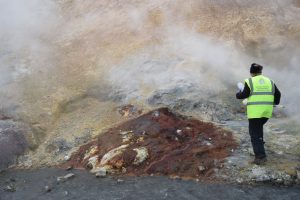
Throughout its history, volcanism and water on Mars likely produced habitable regions below the surface, where geothermal energy interacted with the hydrosphere. The Nili Patera caldera in the Syrtis Major volcanic province exhibits mound morphology and silicic sinter deposits indicating past hydrothermal activity and conditions for a habitable conduit from the potential deep biosphere to the surface. Similar geologic activity could have formed the silica deposits at Home Plate in Gusev Crater, or Nili Patera. These sinters provide ideal locations to concentrate and preserve potential biosignatures that could be targets for future planetary exploration. A NASA Planetary Science and Technology Through Analog Research (PSTAR) project, Seeking Signs of Life in Nili Patera (SSLNP), traveled to 3 hydrothermal sinter sites in Iceland in July-August 2016 and employed several exploration methodologies including: spectroscopic, mineralogic, microscopic, molecular, and geophysical to investigate the biological, environmental and volcanic history of the analog sites. This research determines if molecular biosignatures, such as lipids, are 1) preserved in the sinter and 2) detectable with a benchtop version of the TMAH (tetramethylammonium hydroxide) wet chemistry experiment on the SAM (Sample Analysis at Mars) instrument on the Curiosity rover. With these data we can also begin to deconvolve the microbial ecology within these sinter deposits.
Organic Biosignature Detection with the NASA Mars Curiosity
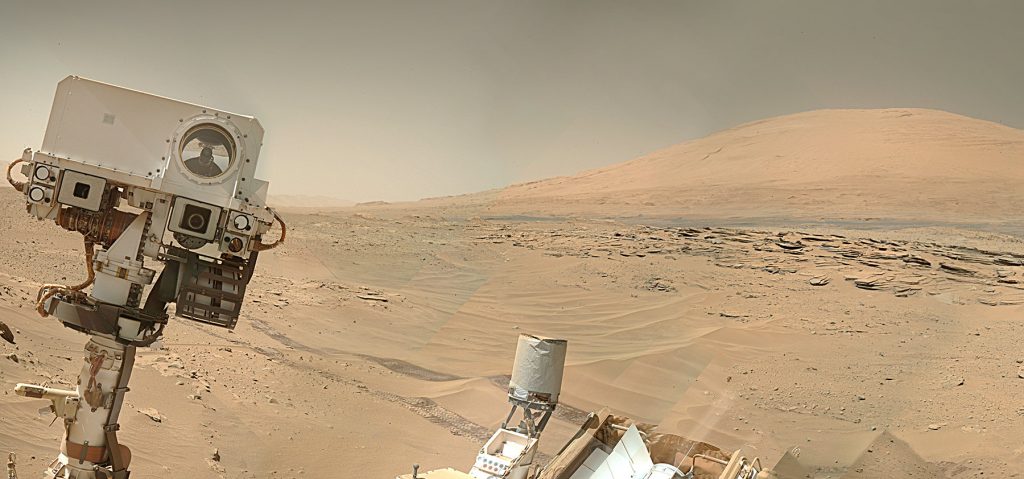
The Mars Curiosity rover is climbing Mt. Sharp, in Gale Crater, exploring stratigraphic packages of rocks for evidence of habitability and searching for organic compounds using the Sample Analysis at Mars (SAM) instrument suite. SAM includes a gas chromatograph mass spectrometer (GCMS) and sample pyrolysis ovens. SAM has the capability of performing wet chemistry experiments, one of which uses tetramethylammonium hydroxide (TMAH) thermochemolysis to make lipids sufficiently volatile for detection by SAM’s GCMS. This project determines the effectiveness of the SAM-like TMAH experiment to liberate organics from a variety of Mars-analogous rock samples. As a member of the Mars Curiosity rover mission and a collaborator on the Sample Analysis at Mars (SAM) instrument team, I am the lead coordinator for the thermochemolysis wet chemistry experiment, which on SAM will use the reagent TMAH to volatilize organic molecules bound in macromolecules (if present), such as biogenic phospholipid fatty acids bound in cellular membranes.
Thermochemolysis and the Detection of Extraterrestrial Organics
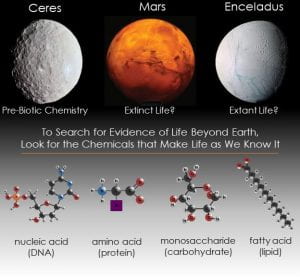
The search for evidence of life beyond Earth is a paramount research question for humanity, and a priority for NASA as one of the three core contexts of NASA’s Strategic Objective 1.1. One of the most promising paths forward to identify evidence for extinct or extant life elsewhere is the detection of organic matter that is characteristic of life. Terrestrial life utilizes four fundamental organic biomolecules (building blocks in parentheses): nucleic acids (nucleotides), proteins (amino acids), carbohydrates (saccharides), and lipids (fatty acids). Of these four biomolecules, nucleic acids, proteins, and carbohydrates have the least preservation potential over geologic timescales, as they can be rapidly degraded by other organisms, but they can indicate extant or recently extinct life. Lipids are also biologically essential and have a large preservation window due to their recalcitrance in the environment and ability be preserved as molecular fossils. All four classes of molecules are important in the search for extant life, extinct life, and pre-biotic chemistry in our solar system. The capability to detect these preserved biomolecules varies greatly depending on the technique utilized. This work focuses on gas chromatography mass spectrometry (GC-MS) techniques as it has the highest heritage, having flown in modified forms on the Mars Viking landers, the Mars Phoenix polar lander, the Cometary Sampling and Composition Experiment on the Philae mission, the Mars Curiosity rover, and the upcoming European Space Agency’s ExoMars rover. The fundamentals of the GC-MS system for all these instruments is essentially the same: the goal of the instrument is the detection and identification of various molecular species and classes at low concentrations with high analytic specificity. Volatile compounds thermally evolved from solid samples in an oven may be directly heated (pyrolyzed) or subjected to a derivatization/ thermochemolysis procedure. The evolved species are then separated by the GC into a time sequence and then separated by mass and analyzed with the MS. These GC-MS derivatization procedures are the focus of this proposal. A derivatization or thermochemolysis step, in general referred to here as in the literature as a “wet chemistry experiment”, is a “one-step” reaction with a reagent that is often required to improve organic matter yield and liberate organics bound within macromolecules. The reagents MTBSTFA and TMAH have flown on space flight missions to Mars, but both reagents have drawbacks. Another reagent option which has not flown on a mission is TMSH (trimethylsulfonium hydroxide), which has the benefits of MTBSTFA and TMAH without many of the drawbacks. TMSH can achieve methylation/ transesterification at lower temperatures than TMAH, does not contribute to the isomerization/ degradation of polyunsaturated fatty acids as does TMAH and other quaternary salts thermochemolysis reagents, and as a byproduct of TMSH thermochemolysis is water, TMSH is amenable to working with aqueous samples, unlike MTBSTFA. The goal of this work is to assess the utility of TMSH as a more effective and versatile methylation reagent for future space-flight missions that utilize thermochemolysis GC-MS. Four tasks are outlined which focus on the performance of TMSH in three analog environmental and geochemical planetary conditions: 1) dwarf planet Ceres’ pre-biotic surface chemistry, 2) Mars’ possible preserved extinct life, and 3) icy ocean worlds with the potential for extant life, such as the outer planet moons of Enceladus and Europa.
FORMER PROJECTS
Discovering Biosignatures in Mn Deposits
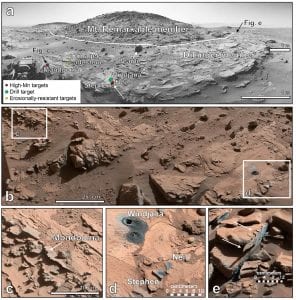
The newly discovered high concentrations of manganese on Mars indicate past episodes of strongly oxidizing conditions within an aqueous environment. On Earth, such simultaneous conditions are almost always both habitable (potentially supportive of life) and inhabited by microbes. Given its close association with life and habitable environments on Earth, manganese has long been considered a principal biosignature for Mars. However, we do not yet understand the unique Mn signatures that can distinguish Mn-rich deposits as biogenic in origin (i.e., produced by life) from altered, abiogenic Mn deposits in rover payload instrument data. While distinguishing between biogenic and abiogenic manganese deposits is possible on Earth with a full suite of terrestrial laboratory instruments, the analytical techniques available on the surface of Mars are far more constrained. A primary goal of the Mars 2020 rover mission is to identify samples containing potential biosignatures for future sample return; thus, it is of the utmost importance that biosignatures that are detectable with the Mars 2020 instrument payload be identified prior to landing on Mars.
A key component of this project is laboratory experiments designed to interpret trace element abundance and mineralogy to conclusively identify Mn-related biosignatures acquired from Mars rover instruments. We will examine confirmed biotic and abiotic Mn-rich materials in detail using gold-standard laboratory techniques such as scanning electron microscopy (SEM) and X-ray diffraction (XRD) to elucidate the signatures of these materials with rover instrument techniques such as laser-induced breakdown spectroscopy (LIBS), which is currently on the Curiosity Mars rover payload (ChemCam), and Raman spectroscopy. While ChemCam is limited to LIBS, the Mars 2020 rover SuperCam instrument will combine LIBS, Raman, and time-resolved luminescence spectroscopy, and the Mars 2020 SHERLOC instrument will provide UV Raman spectroscopy. By developing a thorough understanding of Mn biosignatures in the laboratory, we can remove significant ambiguities that exist in data collected on Mars with measurements from a limited instrument suite and can optimize data acquisition and targeting for the Mars 2020 rover to identify and interpret specific Mn-related biosignatures should they be present on Mars.
This work is supported by the NASA Exobiology Program.
Water Quality of Urbanized University Campus Waterways, Towson, MD
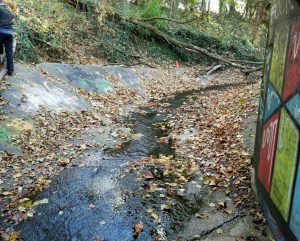
Urban areas are among the fastest growing land cover types. Although research on the geochemistry and ecology of urban streams is growing rapidly, many basic scientific questions regarding urban stream processes remain unanswered. The streams on Towson University’s campus represent ideal settings for addressing these questions because the numerous streams and the urban nature of the campus afford the opportunity for detailed investigation of the effects of urbanization on stream ecosystems. Additionally, some campus streams have experienced recent restoration, and another is scheduled for restoration in 2017. This project documents seasonal changes in water quality, including metal, salt, and nutrient loading, and an assessment of ecosystem health through benthic macroinvertebrate (BMI) surveys. Preliminary results suggest that the streams on campus are dominated by mixed cation and Cl-dominated waters. Specific conductivity ranges up to 1755 µS/cm. [Cl] can exceed 930 ppm, exceeding both the chronic (230 ppm) and acute (860 ppm) EPA criteria for aquatic life. Additionally, [Mn] in some locations exceed the 50ppb EPA secondary maximum contamination levels, and total nitrogen and phosphate concentrations exceeded 3.0 and 0.2 ppm, respectively. Preliminary BMI surveys demonstrate low populations and diversity in the stream slated for restoration. On-campus stream quality is compared to three regional streams in the watershed, Ruxton Run, Roland Run, and Jones Falls, within more rural environments and with fewer impervious surfaces. Specific conductivity in these streams range up to 1271 µS/cm, [Cl] can exceed 364 ppm, exceeding the chronic EPA criteria for aquatic life, [Mn] in few locations exceed the 50ppb EPA secondary maximum contamination levels, and total nitrogen and phosphate concentrations exceeded 3.4 and 1.2 ppm, respectively. Ongoing research will track contributions of salt, nutrients, and metals to campus streams.
Sedimentology and Geochemistry of Gale Crater
Rivera-Hernandez, F., Sumner, D.Y., Newsom, H., Gasnault, O., Maurice, S., Stack Morgan, K., Williams, A.J., Wiens, R., Nachon, M., L’Haridon, J., Forni, O., Mangold, N., 2019. Using ChemCam LIBS data to constrain grain size in rocks on Mars: Proof of concept and application to rocks at Yellowknife Bay and Pahrump Hills, Gale crater, Icarus, DOI: 10.1016/j.icarus.2018.10.023. Link to Article
Cousin, A., Dehouck, E., Meslin, P.-Y., Forni, O., Williams, A.J., Stein, N., Gasnault, O., Bridges, N., Ehlmann, B., Schröder, S., Payré, V., Rapin, W., Pinet, P., Sautter, V., Maurice, S., Wiens, R.C., 2017. Geochemistry of the Bagnold Dune Field as observed by ChemCam, and comparison with other aeolian deposits at Gale crater. Journal of Geophysical Research, Planets, 122, doi: 10.1002/2017JE005261. Link to Article
Edgar, L.A., Gupta, S., Rubin, D.M., Lewis, K.W., Kocurek, G.A., Anderson, R.B., Bell III, J.F., Dromart, G., Edgett, K.S., Grotzinger, J.P., Hardgrove, C., Kah, L.C., Leveille, R., Malin, M.C., Mangold, N., Milliken, R.E., Minitti, M., Palucis, M. Rice, M., Rowland, S.K., Schieber, J., Stack, K.M., Sumner, D.Y., Wiens, R.C., Williams, R.M.E., Williams, A.J., 2017. Shaler: In Situ Analysis of a Fluvial Sedimentary Deposit on Mars. Sedimentology, doi: 10.1111/sed.12370. Link to Article
Mangold, M., Schmidt, M.E., Fisk, M., Forni, O., McLennan, S., Ming, D., Sautter, V., Sumner, D., Williams, A.J., Clegg, S., Cousin, A., Gasnault, O., Gellert, R., Grotzinger, J.P., Wiens, R., 2016. Classification scheme for sedimentary and igneous rocks in Gale crater, Mars. Icarus,http://dx.doi.org/10.1016/j.icarus.2016.11.005. Link to Article
Oehler, D.Z, Mangold, N., Hallet, B., Fairén, A.G., Le Deit, L., Williams, A.J., Sletten, R.S., Martínez-Frías, J., 2016. Origin and Significance of Decameter-Scale Polygons in the Lower Peace Vallis Fan of Gale Crater, Mars. Icarus, 277, 56-72, doi.org/10.1016/j.icarus.2016.04.038. Link to Article
Mangold, N., Thompson, L., Forni, O., Fabre, C., Le Deit, L., Wiens, R., Williams, A.J., Williams, R., Anderson, R., Blaney, D., Calef, F., Cousin, A., Clegg, S., Dromart, G., Dietrich, W., Edgett, K., Fisk, M.R., Gasnault, O., Gellert, R., Grotzinger, J., Kah, L., Le Mouelic, S., McLennan, S., Maurice, S., Meslin,P.-Y., Newsom, H.E., Palucis, M., Rapin, W., Sautter, V., Siebach, K., Stack, K., Sumner, D., Yingst, R.A. 2016. Composition of conglomerates analyzed by the Curiosity rover: Implications for Gale crater crust and sediment sources, Journal of Geophysical Research, Planets, 353-387, doi:10.1002/2015JE004977. Link to Article
Anderson, R., Bridges. J.C., Williams, A.J., Edgar, L., Ollila, A., Williams, J., Nachon, M., Mangold, N., Schieber, J., Gupta, S., Dromart, G.; Wiens, R., Le Mouélic, S., Forni, O., Lanza, N., Mezzacappa, A., Sautter, V., Fisk, M., Blaney, D., Clark, B., Clegg, S., Gasnault, O., Lasue, J., Léveillé, R., Lewin, E., Lewis, K., Maurice, S., Newson, H., Schwenzer, S., Vaniman, D., 2015. ChemCam Results from the Shaler Outcrop in Gale Crater, Mars, Icarus, v. 249, p. 2-21, doi: 10.1016/j.icarus.2014.07.025. Link to Article
